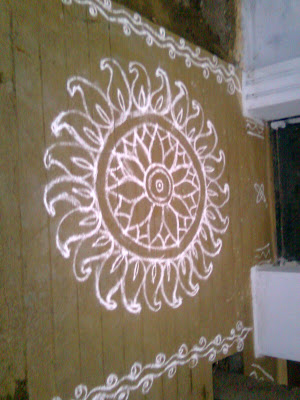Indian, South Indian, Festival - Rangoli & Kolam Collections
Tuesday 21 February 2012
Pongal Kolam
 Pongal rangoli with butterfly design
Pongal rangoli with butterfly designThe traditional form of Rangoli made use of designs and motifs based on nature, such as mango, creepers, flowers, swans, peacocks, etc. Even the colors in the traditional art form were extracted from natural dyes, like barks of trees, leaves, indigo, etc. However, the practice is not much in use now. These days, synthetic dyes have more or less replaced the natural dyes of the earlier times. The materials used in the Rangoli patterns of today give either a very flat appearance or a 3-D effect. Rangoli designs used presently include, geometrical patterns, the swastika, lotus, trident, fish, conch shell, creepers, leaves, trees, flowers, animals, etc.
Numerous households in the Indian subcontinent make use of Rangoli designs for decorating the courtyard of their house.
Thursday 16 February 2012
Colourful Rangoli2
 Stylish rangoli design
Stylish rangoli designKolam is the name given to the art of Rangoli in southern parts of the country, mainly the states of Kerala and Tamil Nadu. The Hindus residing in these parts make use of this art form on a large scale. The female members of the house usually draw Kolam designs in front of their homes, with the help of rice powder. One can also try colored powders used at home, like indigo and spices like rawa, turmeric, rice flour, wheat flour, etc. Whatever design you decide to draw, make sure that it is an unbroken line, with no gaps in between. It is said that a broken line gives an opportunity to the evil spirits to gain entry inside the home.
Colourful Rangoli

Colourful rangoli for pongal occasion with flowers.
The ritual of drawing Rangoli patterns, a skill handed down from mother to daughter is considered an auspicious welcome sign. Women start their chores by drawing Rangoli
designs in front of the threshold, prayer area, courtyards, walls, and
in front of the sacred plant Tulasi. With this daily ritual, the women hope for the day to bring peace,
health, good luck, and prosperity. Like that
of a flower, its freshness is short lived. To the uninitiated, the
impermanence of the Rangoli art can be a candle in the wind. Once its
purpose is served, it is erased and the ritual is repeated with the same
intention and zeal.
Lotus Rangoli
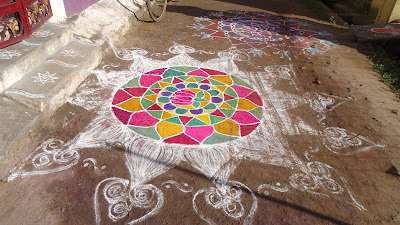
Rangoli with multi lines and few colors.
Various day to day colored powders like indigo used for cloth staining, spices like turmeric,chilli, rice flour, flour of wheat etc. can be used. Powder colors can be simply mixed into the base or sometimes water is used to mix the colours & sandstone powder and then dried.Some fine filter mash (those used for flour or tea )is used to extarct the fine rangoli powder .Some artists can make the Rangoli which looks like a painting/ poster.(see the rangoli paintings in another post).Sprinkling powder by hand is a very laborious and difficult process but it gives immense pleasure to the artist after the completion of rangoli painting.
Multi lines Rangoli

Multi line lotus rangoli with simple design
Rangoli was one of the major decorations or embellishments in the ancient times, but they have not lost their charm even in the modern context. These traditional embellishments are still used in India on various festivals and special occasions like marriages, birth ceremonies, and so. At Diwali, Hindus draw bright Rangoli patterns to encourage the goddess Lakshmi to enter their homes. Rangoli were originally done in small patterns of about 2 foot square, but now entire areas of floor can be covered in intricate designs, often produced by first drawing gridlines in light chalk.
Lotus Kolam
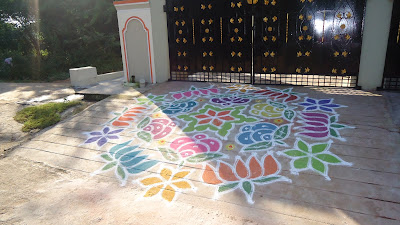
Rangoli with lotus and rose design
Designs are set out to occupy a square, rectangle or circle to show marked protection from all sides. In the olden days, rangolis were made with rice flour and grains. The main idea behind this was to feed the ants, birds and animals as one's good deed of the day.
Colors signify
- RED strength and energy
- YELLOW richness.
- GREEN harmony and balance, nature.
- BLUE vastness and happiness, peace
- ORANGE sacrifice.
Small Rangoli Design

Simple and small rangoli
The main structure of the rangoli is in the shape of a square. There are many other geometrical forms such as circles and triangles contained within the square, hence the connection to maths. Everything has a shape, and maths of shape is called geometry. Circles, rectangles, squares, triangles, octagons, hexagons and so on are all geometric shapes. The beauty of the rangoli lies in the fact that it cannot be preserved for long periods of time as there is no fixed base. It is an art to be enjoyed and appreciated for the moment until it is finally swept away to create a new space.
Simple Rangoli

Traditional lamp rangoli
Well, in Hinduism, every religious tradition or gesture is symbolic of a deeper meaning. Rangolis are not meant for mere beautification of the house but are supposed to prevent evil from entering the home. When you put rangoli, remember you are not adding to the decorations of your house but also making your house an epicenter of positive energy.
Simple Rangoli

Colourful and attractive rangoli.
The word "rangoli" derives from Sanskrit, and it means "the expression of artistic vision through the joyful use of colour" or "design in colour." It is done at the entrance of households or a temple (mandirs) on auspicious occasions, especially during the festivals like Pongal and Diwali, and is hence a welcoming gesture. It also gives that little extra touch of class and beauty. The colourful patterns on the doorsteps are not just for decorative purposes; they embody a deep religious spirit too.
Pongal Rangoli
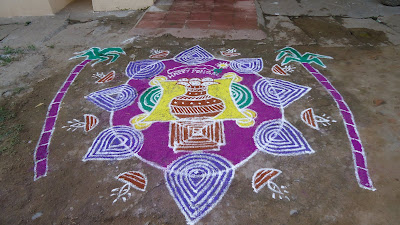
Special pongal pot rangoli drawn during pongal festival. Pongal festival is celebrated to thank nature. It is a four day festival. For as long as people have been planting and gathering food, there has been some form of harvest festival. Pongal, one of the most important popular Hindu festivals of the year. This four-day festival of thanksgiving to nature takes its name from the Tamil word "Ponghu" meaning "to boil" and is held in the tamil month of Thai (January-February) during the season when rice and other cereals, sugar-cane, and turmeric (an essential ingredient in Tamil cooking) are harvested.
Sunday 12 February 2012
Rangoli
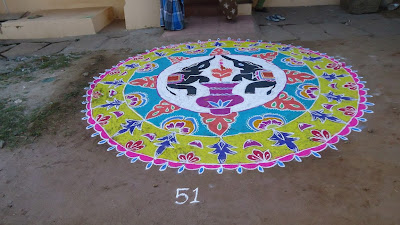
Beautiful Combination for elephant and floral designs. Drawn during pongal festival for rangoli competition. Rangoli design is a safe, beautiful and expressive tool that can bring people together to work towards a common creative goal, transcending age, language or cultural barriers.
Got 2nd price in M.K.Kottai, Trichy Pongal festival Rangoli Competition.
Subscribe to:
Posts (Atom)
